Crookston Sasquatch Sightings
Posted by: Loren Coleman on February 6th, 2007

In 1990, Wisconsin taxidermist and artist Curtis Christensen created the “world’s most unique Bigfoot in existence,” above, and kept it to himself in his barn for a few years. When I talked to Christensen in 2004, he shared that he merely wished to create the model because he had an interest in doing so and he wanted to see how big it would be. (His model stands 8 feet tall and weighs nearly 500 pounds.)
In June 1995, Crookston, Minnesota, based on a series of local sightings, declared itself the “Bigfoot Capital of the World.” Badger State taxidermist Christensen heard about that and contacted the executive director of the Crookston Development Authority. “Would Crookston like to obtain my Bigfoot to go with your new worldwide fame?”, he asked them.
A local eating establishment, RBJ’s Restaurant in Crookston, had become the focal point of interest when someone had the idea to start a Bigfoot “museum.” Hundreds of baby Bigfoot dolls went on sale (I’m still looking for one of those), and the annual Ox Cart Days parade featured two Bigfoot floats. A local convenience store sold bumper stickers and postcards that said: “Crookston, Minnesota: The Bigfoot Capital of the World.”
Before long, the town of Crookston and RBJ’s Restaurant had their Bigfoot. A display next to the Bigfoot model showed photographs of the early spring 1981, Bigfoot tracks found in a cow pasture, near the Gentilly bridge over the Red River, on County Road 11, just outside of Crookston.
For almost half a decade, the Crookston Bigfoot stood in RBJ’s and pictures were snapped by locals and a few passing tourists (the above photo is from that time period). The television program “Sightings” showed up and taped part of a Bigfoot episode there. Rumors had it that Ripley’s Believe It or Not was interested too.
But then the model disappeared. While the Crookston Bigfoot was a hit, the Bigfoot museum never got off the ground in isolated Crookston. No throng of tourists stopped by Crookston. The desire to have the Crookston Bigfoot establish its own identity, and be called, as the local newspaper wrote, the “Plains Bigfoot or the Field Running Bigfoot,” never caught on.
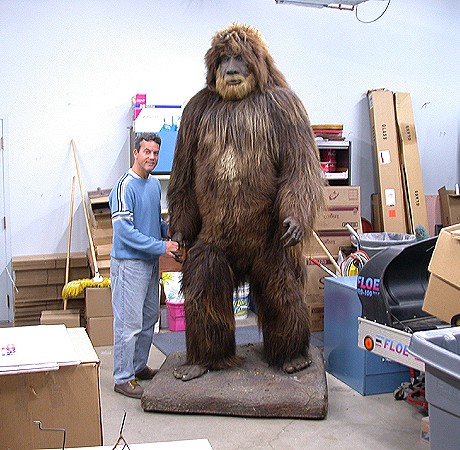
I began a search for whatever happened to the Bigfoot, and finally found the giant “carcass” in a warehouse in the Minneapolis-St. Paul area. As I told the media in 2004: “It wasn’t easy tracking it down, which, of course, is pretty typical of anything to do with Sasquatch.”
What I discovered was that a tool company in Minneapolis obtained the Bigfoot and had been displaying it successfully. The owner of the corporation told me: “I was always fascinated with Bigfoot growing up and when I saw this I couldn’t resist. We’ve taken it to trade shows and people got their photo with him. People love it and it creates such a memory.”
Most of the time, however, the Crookston Bigfoot was in a Minneapolis warehouse (as pictured above). I couldn’t afford to buy it when the owner first put it up for sale in 2001, but finally, through talks with the owner, the time came for the Bigfoot to find a more permanent home, in Portland, Maine, during the summer of 2004.
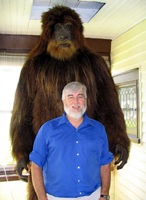
Above, Loren Coleman and the Crookston Bigfoot, summer 2005, taken by Joseph Citro, a photograph which also appears in his Weird New England.
Following years of showing interest, I was overjoyed to make arrangements for the Crookston Bigfoot’s trip to New England. After a safe one week journey via Roadway Trucking, what one television company had called “the best looking Bigfoot replica in existence,” arrived safely at my more accessible location for Sasquatch scholars and fans to see it (by appointment). From 2004 through 2006, I never charged admission for a visit with the Crookston Bigfoot at my museum and my time, a lá Field of Dreams, but several people have suggested to me I should have.
Anyway, beginning in 2006, I temporarily closed The International Cryptozoology Museum, due to the fact several objects – including the Bigfoot – were on loan to the Bates College Cryptozoology exhibition, which would have showings in Maine and Missouri.
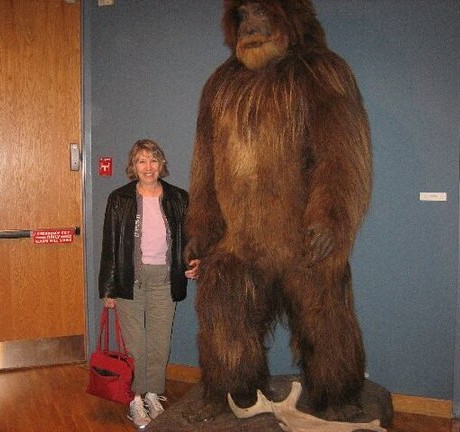
Julie Moore has her picture taken next to the Bigfoot at Bates.
First, the Bigfoot traveled to Bates College, and stood as the final item of the exhibition, to be observed at the end of the long room filled with all the nonfiction items from my collection. Many people took the time to be photographed in front of or next to it (as above).
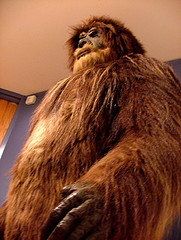
Michelle Souliere’s beautiful photograph of the Bigfoot at the Bates College “Cryptozoology” exhibition gives a view of how impressive it can look, up close.
Next, the model was shipped out to Missouri, to the H & R Block Artspace. The Kansas City Star had this to say about the Bigfoot’s place in the traveling exhibition there:
Over it all, like a benevolently intimidating patriarch, stands the 8-foot tall, 500-pound Crookston Bigfoot. If ever there was an inspiration to create a shrine to Bigfoot, this room is the starting point for it.

While in Kansas City, Professor Hex and his nieces visited the H & R Block Artspace exhibition, and took a good picture showing the setup there, complete with the moose antler at its feet. Professor Hex’s photo also demonstrates an interesting artifact of photography and the reality of what is being captured on film. Compare his photograph with the others. The color of the Kansas City-exhibited Bigfoot looks much darker, a very dark brown, almost black, in the Artspace’s lighting as “seen” through Professor Hex’s camera. The Bigfoot is the same, but the settings, cameras, and circumstances are varied to such an extent the results show a remarkable diversity of different colored Sasquatch. This is a good lesson to learn in analyzing photos and eyewitness accounts of Bigfoot.
The Crookston Bigfoot put a face on the exhibition, especially for Sasquatch seekers. The curators and creators of the exhibition, Mark Bessire and Raechell Smith captured the essence of the big guy in their book Cryptozoology: Out of Time Place Scale, which was highlighted in David Pescovitz’s Boing Boing blog on the volume and the exhibition.
Now, although still in transit, this elusive 8 feet tall Sasquatch has been snagged again, and the Bigfoot will be back at home in Maine, soon, maybe in three weeks. Perhaps it is time for the “Crookston Bigfoot” (which only had that moniker for about four years) to be renamed? Might it be time to move away from the use of “Crookston”? Any suggestions?
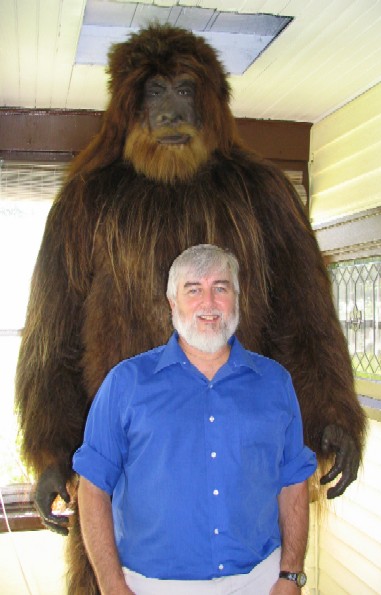
About Loren Coleman
Loren Coleman is one of the world’s leading cryptozoologists, some say “the” leading living cryptozoologist. Certainly, he is acknowledged as the current living American researcher and writer who has most popularized cryptozoology in the late 20th and early 21st centuries.
Starting his fieldwork and investigations in 1960, after traveling and trekking extensively in pursuit of cryptozoological mysteries, Coleman began writing to share his experiences in 1969. An honorary member of Ivan T. Sanderson’s Society for the Investigation of the Unexplained in the 1970s, Coleman has been bestowed with similar honorary memberships of the North Idaho College Cryptozoology Club in 1983, and in subsequent years, that of the British Columbia Scientific Cryptozoology Club, CryptoSafari International, and other international organizations. He was also a Life Member and Benefactor of the International Society of Cryptozoology (now-defunct).
Loren Coleman’s daily blog, as a member of the Cryptomundo Team, served as an ongoing avenue of communication for the ever-growing body of cryptozoo news from 2005 through 2013. He returned as an infrequent contributor beginning Halloween week of 2015.
Coleman is the founder in 2003, and current director of the International Cryptozoology Museum in Portland, Maine.










Well, let’s see. A few ideas-
There’s the neo pedantic: Crookston Speculative Primatological Display.
There’s the flippant: Murray.
There’s the bureaucratic: Bigfoot Model CR-01.
Loren, I’m curious as to how the face and hands were created. Are they carved out of wood or modeled out of skins?
No. Not wood nor skins. The face, hands, and feet are molded from a hard, rigid form of some type of plastic. The created base, appearing to be like a rocky terrain, is something like painted plaster (or a similar material) over a mesh (which shows through in some of the cracks due to the model’s travels).
How about naming it for the artist?
Or Perhaps ‘The Traveler’s Bigfoot,’ for it’s travels?
I like the name Crypto myself, but wasn’t that the name of Superman’s dog? (Spelled with a K, of course.)
“Christensen’s Bigfoot” makes sense, but that is a distractingly long name for which anyone would trip over it in trying to say it or pronouce it too many times.
Keep trying..
🙂
Side issue:
This model has a distinctly lighter-colored beard. Was the intention to create something out of Mark Hall’s ‘Marked Hominid’ category? I would think that it matches that description rather than the Nothwest coast/’Patty’ sort of Sasquatch.
Was it based on reports that included the lighter-colored beard as a feature?
The creator expressed to me that he had no imagery model, in reality or fiction. Nevertheless, the dominating influence in America for “what” a Bigfoot looked like during this time period was Harry and the Hendersons. The movie came out in June 1987, and I think people may forget how significant it was. It was a top ten movie, and its popularity resulted in a television series that aired from January 1991 to June 1993.
The model’s builder, I’ve also thought, was unconsiously impacted by the Bigfoot in Harry and the Hendersons.
It’s from the Red River Valley of the North, and Crookston in particular.
It should be named after me 😉 a proper name no ? 🙂 I couldn’t help it I had to 😉
Well Loren, given the similarity in facial hair, maybe you could just call it “Junior”. 😉
Great statue! I love the kind of raised eyebrow which makes it look like it has a mischevious glint in its eye. Very cool.
Just curious… who’s the guy with the grey beard and blue shirt?
Is this the Maine Monster?
LOL